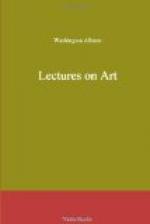that is, without thinking of a whole. Is this
impossible? Is it altogether out of experience?
We have already shown (as we think) that no
unmodified
copy of actual objects, whether single or multifarious,
ever satisfies the imagination,—which imperatively
demands a something more, or at least different.
And yet we often find that the very objects from which
these copies are made
do satisfy us. How
and why is this? A question more easily put than
answered. We may suggest, however, what appears
to us a clew, that in abler hands may possibly lead
to its solution; namely, the fact, that, among the
innumerable emotions of a pleasurable kind derived
from the actual, there is not one, perhaps, which is
strictly confined to the objects before us, and which
we do not, either directly or indirectly, refer to
something beyond and not present. Now have we
at all times a distinct consciousness of the things
referred to? Are they not rather more often vague,
and only indicated in some
undefined feeling?
Nay, is its source more intelligible where the feeling
is more definite, when taking the form of a sense
of harmony, as from something that diffuses, yet deepens,
unbroken in its progress through endless variations,
the melody as it were of the pleasurable object?
Who has never felt, under certain circumstances, an
expansion of the heart, an elevation of mind, nay,
a striving of the whole being to pass its limited
bounds, for which he could find no adequate solution
in the objects around him,—the apparent
cause? Or who can account for every mood that
thralls him,—at times like one entranced
in a dream by airs from Paradise,—at other
times steeped in darkness, when the spirit of discord
seems to marshal his every thought, one against another?
Whether it be that the Living Principle, which permeates
all things throughout the physical world, cannot be
touched in a single point without conducting to its
centre, its source, and confluence, thus giving by
a part, though obscurely and indefinitely, a sense
of the whole,—we know not. But this
we may venture to assert, and on no improbable ground,—that
a ray of light is not more continuously linked in
its luminous particles than our moral being with the
whole moral universe. If this be so, may it not
give us, in a faint shadowing at least, some intimation
of the many real, though unknown relations, which
everywhere surround and bear upon us? In the deeper
emotions, we have, sometimes, what seems to us a fearful
proof of it. But let us look at it negatively;
and suppose a case where this chain is broken,—of
a human being who is thus cut off from all possible
sympathies, and shut up, as it were, in the hopeless
solitude of his own mind. What is this horrible
avulsion, this impenetrable self-imprisonment, but
the appalling state of despair? And what if
we should see it realized in some forsaken outcast,
and hear his forlorn cry, “Alone! alone!”
while to his living spirit that single word is all
that is left him to fill the blank of space? In
such a state, the very proudest autocrat would yearn
for the sympathy of the veriest wretch.




